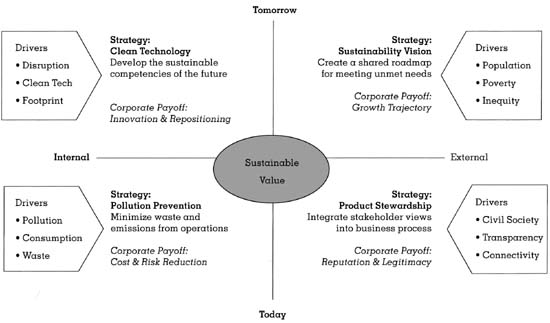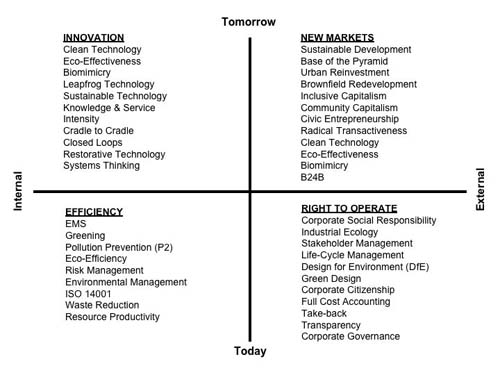
BRINQ is the home of entrepreneur and product designer Patrick Donohue, whose work focuses on high impact startups and products.

“Ever had one of those conversations,” Stu Hart asked the crowd, “where you think you and another person are talking about the same thing, only to discover you’ve been discussing something completely different? In my work, I run into that all the time.”
Stuart Hart is a professor at Cornell’s Johnson School of Management, recent author of the acclaimed “Capitalism at the Crossroads”, and one of the world’s foremost experts on the strategies and business opportunities for sustainable enterprises and serving the world’s poor. Hart was co-presenting with colleague Mark Milstein (of the World Resources Institute) at Cornell’s 3rd annual Sustainable Enterprise Symposium.
Hart and Milstein explained that there are so many different “sustainability tribes”, each using their own vocabulary of buzzwords, that even basic communication proves difficult and unwieldy; strategic planning and collaboration are even harder. How can we collaborate in creating a better future if we can’t even communicate?
Even our lingo is different, take a look at some of the buzzwords in the table below, how many do you recognize?
Tribal Lingo – Sustainability Buzzwords
| Environmental Management Greening Industrial Ecology Stakeholder Management Life-Cycle Management Pollution Prevention (P2) Sustainable Development Design for Environment (DfE) Green Design Urban Reinvestment Brownfield Redevelopment ISO 14001 Waste Reduction Closed Loops Resource Productivity Sustainable Technology Radical Transactiveness Systems Thinking Corporate Governance |
Clean Technology Eco-Efficiency Eco-Effectiveness Biomimicry Triple Bottom Line Inclusive Capitalism Base of the Pyramid Community Capitalism Corporate Citizenship Voluntary Regulation Civic Entrepreneurship Full Cost Accounting EMS Risk Management Leapfrog Technology Cradle to Cradle Restorative Technology B24B Take-Back Transparency |
In “Creating Sustainable Value” (Academy of Management Executive, 2003, Vol. 17 No 2) Hart and Milstein provide a Rosetta Stone for laying out the lingo, the Sustainable Value framework.

Source: Hart & Milstein, “Creating Sustainable Value”
The model is built with two dimensions, sources of “creative tension for firms”. On the horizontal axis you have the firm's need to optimize internal capabilities on the left contrasting with its need to engage external stakeholders and customers on the right. On the vertical axis you have the firm's need to manage its current business on the bottom contrasting with its need to create new market opportunities on the top. The quadrants can be broadly categorized into four “sustainability tribes”:
Hart and Milstein state the bottom half of the model is about “evolution” of a firm’s capabilities, while the top half is about “revolution”. Depending on its growth stage, a firm may be more engaged in one than the other, but in the long-run successful firms need to engage in both. They also need to recognize that the strategies required for each quadrant are very different, even if they’re all considered “sustainable”. For example, to pursue efficiency a firm should focus on resource productivity, whereas to purse new markets the firm needs to look at meeting unmet needs: very different tools are needed for both.
So where do our list of buzzwords fall? Hart & Milstein suggest the following breakdown:

Hart and Milstein are clear about where their interests lie, in the revolutionary top half of the model, with Innovation and New Markets. “That’s not to say the bottom half isn’t important,” said Hart, rather that their particular emphasis, their tribe, is just in the top half. Given Stu and Mark’s influence on us, it’s probably no surprise that BRINQ’s tribe is right up there with them: our favorite buzzwords being “leapfrog technologies”, “base of the pyramid”, and “radical transactiveness”.
What are yours?
Note: For much more in depth coverage of strategies and examples see “Creating Sustainable Value” (Academy of Management Executive, 2003, Vol. 17 No 2) or in Chapter 3 "The Sustainable Value Portfolio" of Capitalism at the Crossroads.
Past “How to Change the World” articles:
Lighting Up the Crossroads – You Need More than Magic – Unleashing Competitive Imagination – The Fortune at the Bottom of the Pyramid – The Model T Trap – Going Beyond Networking